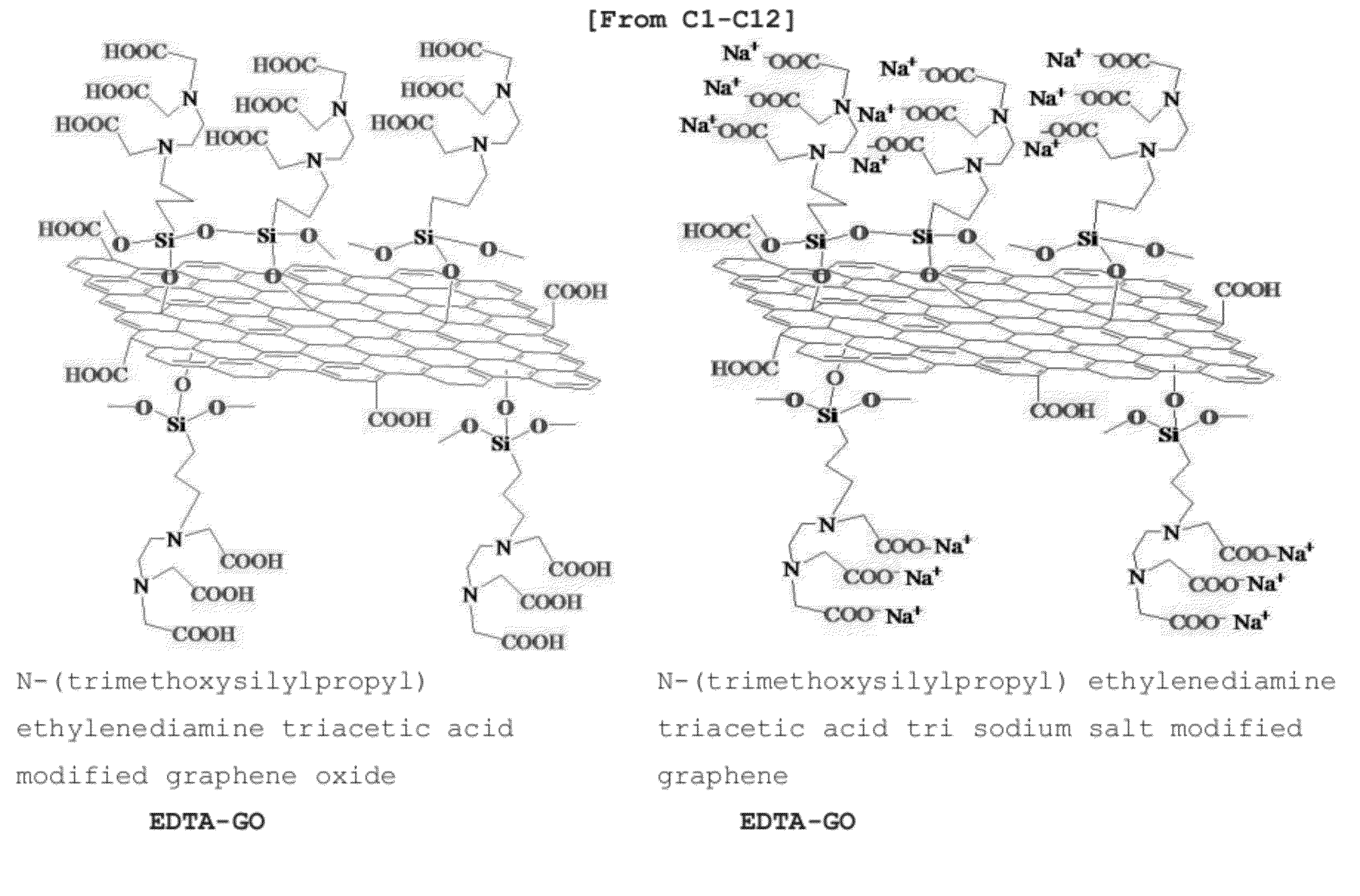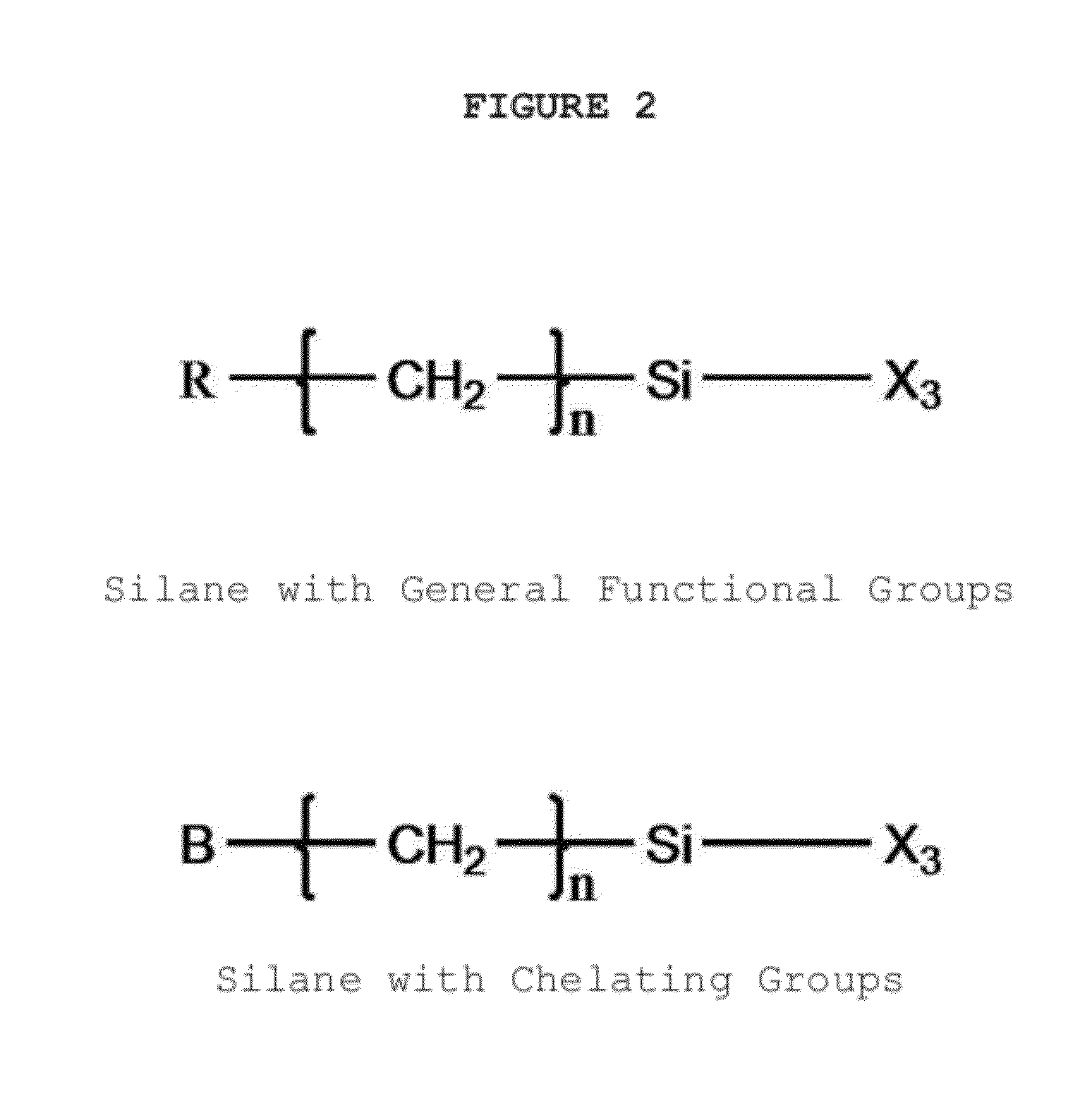Chelating agent modified graphene oxides, methods of preparation and use
a technology of graphene oxide and chelating agent, which is applied in the direction of electrochemical generators, water/sewage treatment by ion exchange, cell components, etc., can solve the problems of reduced graphene oxide, low electrical conductivity of graphene oxide, poor solubility of water, etc., and achieve the effect of improving the performance of traditional lead-acid battery systems
- Summary
- Abstract
- Description
- Claims
- Application Information
AI Technical Summary
Benefits of technology
Problems solved by technology
Method used
Image
Examples
example 1
Preparation of Pre-Treated Graphite
[0057]Graphite (from Aldrich) was used for the preparation of graphene oxide by a modified Hummers' method. Graphite powder was first oxidized by sulfuric acid. 0.1 g, 0.5 g, 1 g, 5 g and 10 g of the graphite powder was first treated with a solution by mixing 1, 5, 10, 50 and 100 ml of concentrated H2SO4 with 0.1, 0.5, 1, 5 and 20 gg K2S2O8 and 2, 5, 10, 15 g and 20 g P2O5 respectively. The mixture was kept at 20˜90° C. for 1˜24 hours using a hotplate. Then, the mixture was cooled to room temperature and diluted with 100 ml, 250 ml, 500 ml, 1.0 L and 2.0 L de-ionized (DI) water respectively and left overnight at room temperature. The mixture was filtered and the solid product was washed with deionized water to remove any residual acid and dried under ambient conditions overnight to obtain pre-treated or pre-oxidized graphite.
example 2
Synthesis of GO Powder
[0058]The pre-oxidized graphite from example 1 was subjected to oxidation by Hummers' method. 0.1 g, 0.5 g, 1 g, 5 g and 50 g pretreated graphite powder was put into 1 ml, 5 ml, 10 ml, 20 ml and 50 ml cold (0° C.) concentrated H2SO4. Then 0.1 g, 0.5 g, 1 g, 5 g and 50 g KMnO4 were added gradually under stirring, and the temperature of the mixture was kept below 20° C. by cooling. The mixture was then stirred at 35° C. for 4 hours and then diluted with 10, 50, 100, 200 and 500 ml DI water. The dilution was carried out in an ice bath to keep the temperature below 40˜50° C. After adding DI water, the mixture was stirred for 30 mins to 24 hours, and then an additional 50, 250, 500, 1000 and 2500 ml DI water was added. Shortly thereafter, 1, 5, 10, 20, and 50 ml30% H2O2 was added to the mixture, and the color of the mixture changed into brilliant yellow and began bubbling. The mixture was filtered and the solid product was washed with 0.1 M HCl to remove metal ions,...
example 3
Preparation of EDTA-GO
[0059]1, 2, 5, 10 and 100 mg GO was added to a three-neck flask with 10, 20, 50, 100 and 500 ml ethanol respectively and dispersed into ethanol using ultrasonication for 1˜60 min. Then 1˜50 ml 0.1˜15% hexane, acetonitrile and ethanol solution of N-(trimethoxysilylpropyl) ethylenediamine triacetic acid or N-(trimethoxysilylpropyl) ethylenediamine triacetic acid tri sodium salt (EDTA-silane) was added and stirred for 1˜48 hours at 30-85° C. to complete GO silylation. After the reaction was finished, 100 ml of water, ethanol and methanol was added to dilute the unreacted silane molecules. The product (EDTA-GO) was obtained by filtration and washed with methanol and water sequentially and then dried.
PUM
| Property | Measurement | Unit |
|---|---|---|
| size | aaaaa | aaaaa |
| size | aaaaa | aaaaa |
| width | aaaaa | aaaaa |
Abstract
Description
Claims
Application Information
 Login to View More
Login to View More - R&D
- Intellectual Property
- Life Sciences
- Materials
- Tech Scout
- Unparalleled Data Quality
- Higher Quality Content
- 60% Fewer Hallucinations
Browse by: Latest US Patents, China's latest patents, Technical Efficacy Thesaurus, Application Domain, Technology Topic, Popular Technical Reports.
© 2025 PatSnap. All rights reserved.Legal|Privacy policy|Modern Slavery Act Transparency Statement|Sitemap|About US| Contact US: help@patsnap.com



